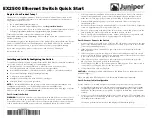
38
OUTPut:DIGital
The following OUTPut command is used to set I/O channels as input ports or output ports:
:STATe <b>, <clist>
Set I/O channel(s) as input or output
:STATe? <clist>
Query port type
Use to set (or query) the specified I/O channels as either output ports or input ports. Parameter value “0” (or off) sets the
channels as input ports. Parameter value “1” (or on) sets the channels as output ports.
The :STATe? <clist> command queries the port type for the specified I/O channels. A “0” or a “1” will be returned for each
channel in the list:
0 = Input port
1 = Output port
For example, the following command queries port type for I/O channels 11, 12, 13, and 14:
OUTP:DIG:STAT? (@111:114)
The response message “0, 0, 1, 1” indicates that channels 11 and 12 are input ports, and channels 13 and 14 are output ports.
SENSe:DIGital[:DATA]
Using remote programming, the Model 7707 can read four 8-bit digital patterns (bytes), two 16-bit digital patterns (words), or
one 32-bit pattern. The input bit pattern can read using the decimal, binary, hexadecimal, or octal format.
:FORMat <name>, [<NRf>]
Select data format for reading input patterns
:FORMat?
Query data format
Select (or query) the data format for reading digital input patterns. The :BYTE?, :WORD? and :DWORd? commands are used
to read digital input patterns.
The response message for :BYTE?, :WORD? and :DWORd? will be a value that corresponds to the input pattern. The binary
format (BINary) allows you to directly identify which bits are set. For example, for a returned binary value of #B100101, bits
B5 (MSB), B2, and B0 (LSB)
are set. When using one of the other data formats, you will have to convert the returned value to
its binary equivalent to determine which bits are set.
The optional <NRf> parameter is used to specify the length of the byte/word/dword returned by the :BYTE?, :WORD? and
:DWORd commands. Parameter value “0” will return the complete byte/word/dword but not include any leading zeroes.
Parameter values 1 to 32 sets the length (number of digits) of the byte/word/dword. If the length is too small for the value, then
the least significant digits of the byte/word/dword will be truncated.
When the :FORMat? command is sent, the response message will indicate the selected data format and the length for the
returned pattern (i.e., BIN, 0).
NOTE
The SENS:DIG[:DATA]:FORM command is coupled to the OUTP:DIG:FORM command. That is,
they both perform the same function. Either one of these commands can be used to set the format
for returning digital I/O bit patterns.
:BYTE? <clist>
Read input byte patterns
Use to read an 8-bit input pattern (byte) present on the specified input channel(s). Input channels 11, 12, 13, and 14 can be read
as 8-bit input ports. When reading a byte, Bit B0 will be the LSB, and Bit B7 will be the MSB, as shown in
NOTE
Only channels 11, 12, 13, and 14 are valid with the :BYTE command. Using any other channel
number(s) with the command generates error -221 (settings conflict).
Summary of Contents for 7707
Page 55: ...52 Specifications 7707 Multiplexer Digital I O Module...
Page 58: ......
















































